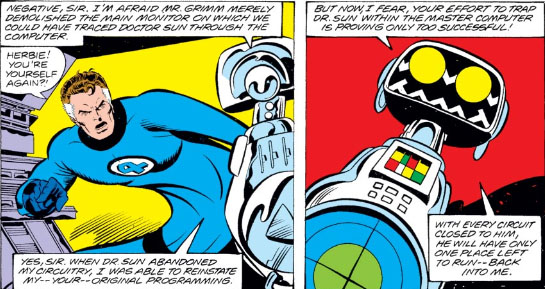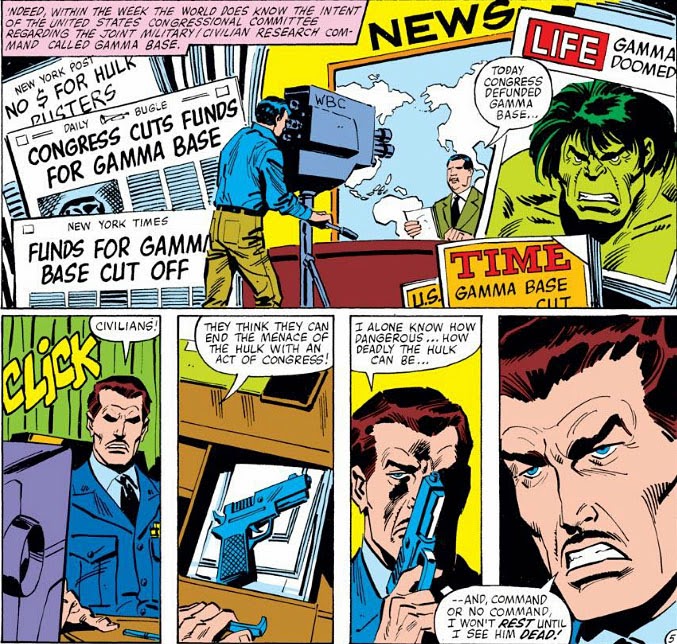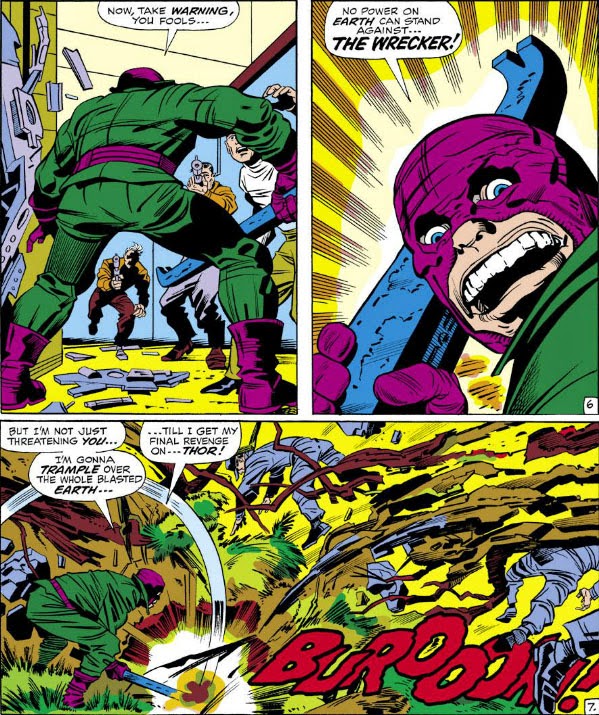![]()
It took a little self-nudging for me to pull the
Avengers/Invaders series from my shelves and give it another look after six years. It was a twelve-issue series which began fairly well, but which seemed to lose its way for me about two-thirds of the way through; in fact, I noticed that I didn't even
have the last four issues. For me to have pulled the plug on this series so close to the finish line surprised me in this second look, since I was enjoying reading it again. I have an idea of what might have been at least
part of the reason I eventually lost interest in it; but since I might end up with a different perspective on the story this time around, I'd rather not jump to any conclusions at this point and just take events in progression.
In a way, the layout of the story almost wants to accommodate me in that respect, splitting the series into three "Acts" of four issues each--presumably to take into account the curious two-month publication gap between issues 4 and 5 and issues 8 and 9. On the other hand, that gap might have helped to make my decision easier in dropping the series, having sixty days to wait for the next issue and finding I lacked any anticipation for it. At any rate, it seems a reasonably good idea to structure this look at the series in four-issue increments. The transition between Acts is rather seamless, so chances are you'll notice no shift in the story's momentum.
While the Avengers get top billing, you'll find that the Invaders receive a generous amount of story attention throughout this first Act, which was really a nice surprise--particularly when you take into account that there isn't just one team of Avengers in this series, but two. That's a lot of characters to keep spinning on plates and make sure they stay relevant, something which the
Secret Wars series didn't manage all that well. To be honest, I wasn't expecting the Invaders to be much more than window dressing--but just look how well scripter Jim Krueger and artist Steve Sadowski start things off, with Bucky (yes,
Bucky, whom we don't normally associate with the word "profound") supplying the narrative in impressions taken from his "war journal":
In just a few panels, Bucky gives a well-rounded profile of the entire team that made even a non-
Invaders reader like myself want to keep turning the pages and read more.
You'll also notice in this series how well Krueger isolates the thinking and priorities of characters from both 1943 and 2008. For instance, the Avengers aren't fighting a world war, and their operations involve meeting threats as they present themselves; while the Invaders are fighting a long, drawn-out conflict in the trenches, seeing large-scale death on practically a daily basis. War is all the Invaders know, its ending their only goal. It wouldn't surprise me if Bucky's war journal is his
only journal.
As for what brings the Invaders forward in time to 2008, we'll have to wait a bit to find out the specifics. But a mysterious mist will do for now.
In 2008, the Civil War has come to an end, and Director of S.H.I.E.L.D. Tony Stark has seen his agenda fall into place. Super-beings are required to register themselves with the government, which in effect makes them responsible for their actions and accountable to the government. As for Stark, he holds
himself accountable (if indirectly) for the death of Captain America; and though Stark oversees a team of Avengers, the former "New Avengers" have remained underground and refuse to undergo registration.
When the Invaders appear, it's in the middle of a fight between Spider-Man and the Thunderbolts, attempting to arrest him in violation of the Registration Act. The Invaders' arrival brings everything to a screeching halt, with both the Thunderbolts and Spider-Man understandably confused, especially at seeing Captain America again; but the Thunderbolts are on a mission and decide to pull what they think is rank on the newcomers, who have just left a combat situation and are already suspicious of their new surroundings.
The Invaders deal with the Thunderbolts, and decide to make tracks afterward in order to sort things out. But news travels fast, and, given the danger to the timeline, Stark and the Avengers are already making plans to locate and contain the Invaders.
In their encounter with the team from the past, the Avengers' hands are tied as far as informing Captain America of their association with him, or otherwise giving the Invaders any information that might impact on the past. For their part, the Invaders are still in a World War II mindset, still suspicious of a probable Nazi trap. So when the Avengers go in, they don't face anyone who's receptive to talking things over or standing down--they face a battle-hardened group that's trained to go on the offensive:
But the Avengers are not the Thunderbolts, and the response of Ms. Marvel's team is quick and coordinated, having the advantage of knowing the capabilities and powers of their foes ahead of time. Yet, whether in the 1940s or in the 21st century, there's one man whose fighting spirit has taken on superior forces with every expectation of winning, a man the Avengers know only too well.
Cap and Namor at this point are the last two Invaders standing. But the Avengers realize the stakes involved, and now isn't the time to allow their feelings for Cap to stand in the way of what they have to do:
Namor manages to escape and vows to return with help, though we've
already seen what transpires in his search for new allies. The rest of the Invaders are taken to the Helicarrier and confined. Under the circumstances, Iron Man can divulge only so much to Cap, and ends up providing him only assurances rather than explanations.
If it seems like Cap is biding his time, you've read him correctly. And the following scene--a splendid example of Bucky's unsung threat level--is likely the reason why:
As we see, this team remains in full 1940s mode, where a prison exists to be busted out of and the enemy is there to be overcome. The Invaders really have no reason to cooperate with their captors, having received no substantive information on who these people are nor having any reason to believe that this isn't anything other than an elaborate Nazi trap. But while they're cooling their heels, the story adds two more developments. First, Paul Anselm, one of the soldiers fighting alongside the Invaders when they were engulfed by the mist which brought them through time, has also found himself in 2008 and feels compelled to look up his older self:
And secondly, the New Avengers feel compelled to free the Invaders. And if it deals Stark a blow in the process, so much the better:
We find out later that the New Avengers' actions aren't as self-centered and short-sighted as we're led to believe here. Dr. Strange, a part of their group, has investigated the chain of events and has stated the importance of returning the Invaders to their own time. But he's discovered there are other, more mysterious factors in play:
Aboard the Helicarrier, as Bucky makes his move, Toro is being examined by SHIELD techs, who discover that their subject qualifies for a very special classification:
There's another curious development put in motion--one which brought a "Huh??" reaction from myself and seems liable to take this story off-track. The Torch, incarcerated in a special soaking room, is visited by one of SHIELD's Life Model Decoys which looks to the Torch to liberate the LMDs from servitude. If you're wondering how the LMD has shifted in purpose from being a decoy construct used in spy operations to being cranked out on the assembly line to be programmed as soldiers and used as cannon fodder, join the club. Stark seems to have brought a radical perspective to SHIELD as its director.
Given the circumstances of the Torch's origin, the LMDs have found the perfect non-human construct to sympathize with them; the question is, why dilute the story with what seems like a plot that's been sitting on a shelf waiting for the right issue to come along for it? Is this really the time for another story along the same lines of the Alpha Primitives of the Inhumans, or the Doom androids led by Andro, the former Doomsman?
I vote we return to the main story--who's with me? First, Toro has played along with the lab techs studying him until he could access his powers again and free himself--while Bucky's movements toward freeing his comrades have been making a mockery of SHIELD procedures and agents, to the delight of Cap. However, when the two reach the flight deck, they're stunned to see that this ship is actually located miles up in the sky. While Cap tackles the LMDs sent against him by Stark, Bucky heads below to join up with Toro and free the Torch, who is horrified to discover that Cap is destroying the LMDs.
Iron Man then joins the fray, and takes on Cap again while the Avengers arrive to head off and secure the Invaders. But the team discovers a new threat along the way:
(No, I don't know why the Black Widow is firing on SHIELD agents, since she's part of the group of Avengers that's working with Stark. You'd think her target would be the webbed guy swinging in front of her.)
Meanwhile, Namor has rejoined his team, which is poised to join the New Avengers in battling Stark's Avengers--while Strange makes another disturbing discovery:
And speaking of disturbing, the word will soon describe Bucky's reaction when he's pulled from the battle by a new figure in this mêlée:
With a scene that hopefully piques the reader's interest enough to last two months, Act One comes to an end. Again, there seems no reason to think at this point that this isn't going to turn out to be anything other than a fine series by the time it reaches its conclusion. Krueger and co-plotter Alex Ross have laid things out sensibly--all characters have been true to form, particularly the Captain America of the 1940s who has considerably more tunnel vision than his future self--and there are enough unanswered questions in play to maintain a level of interest, with eight issues giving the plot room to breathe. Will this series be able to go the distance? Since I'm going through it with no clear memory of my first reading, and without any knowledge of its last four issues, I'll be right there with those of you who are getting your first look at it.
![]() | Avengers/Invaders #s 1-4
Plot: Alex Ross and Jim Krueger
Script: Jim Krueger
Pencils and Inks: Steve Sadowski
Letterer: Todd Klein |









































































































































































































































































